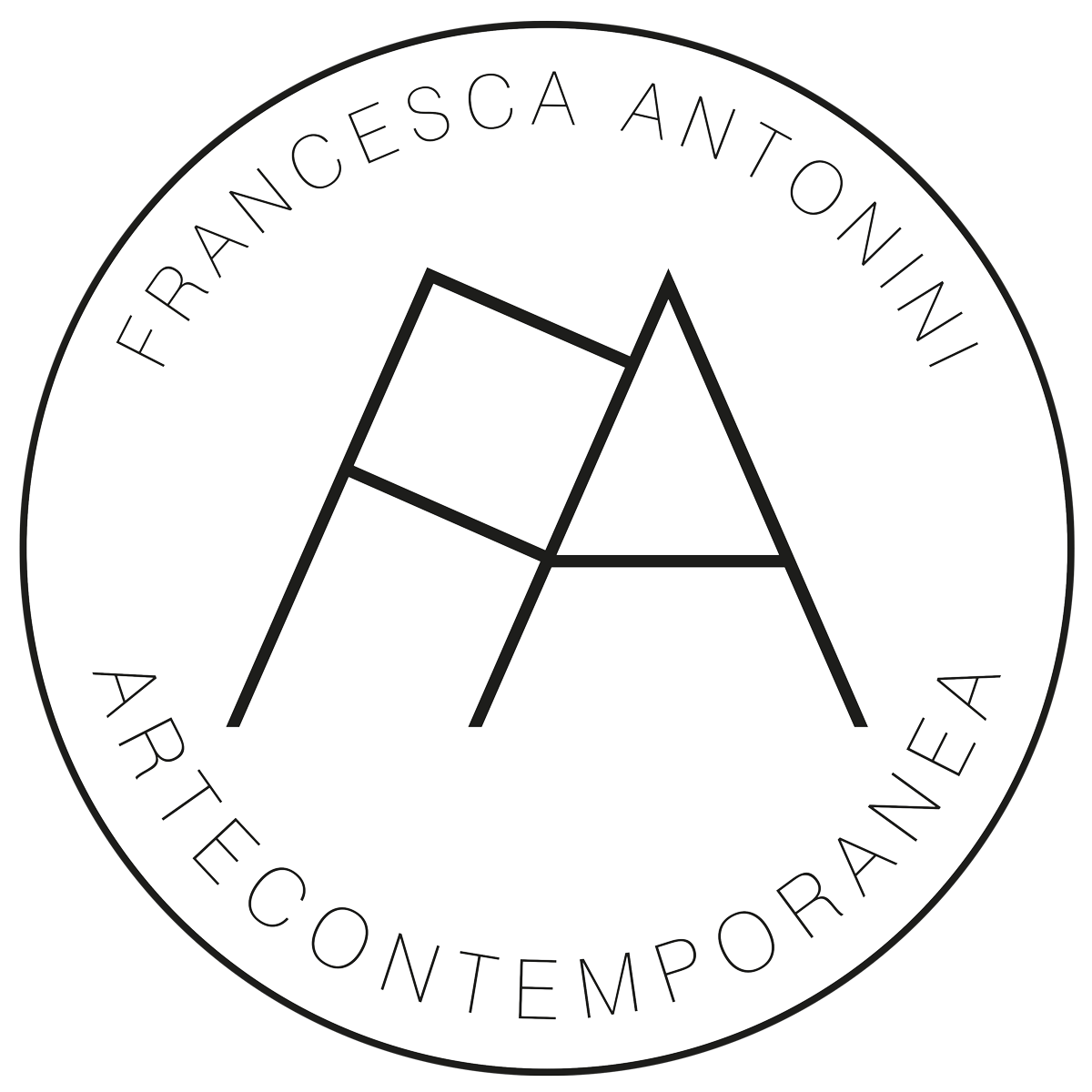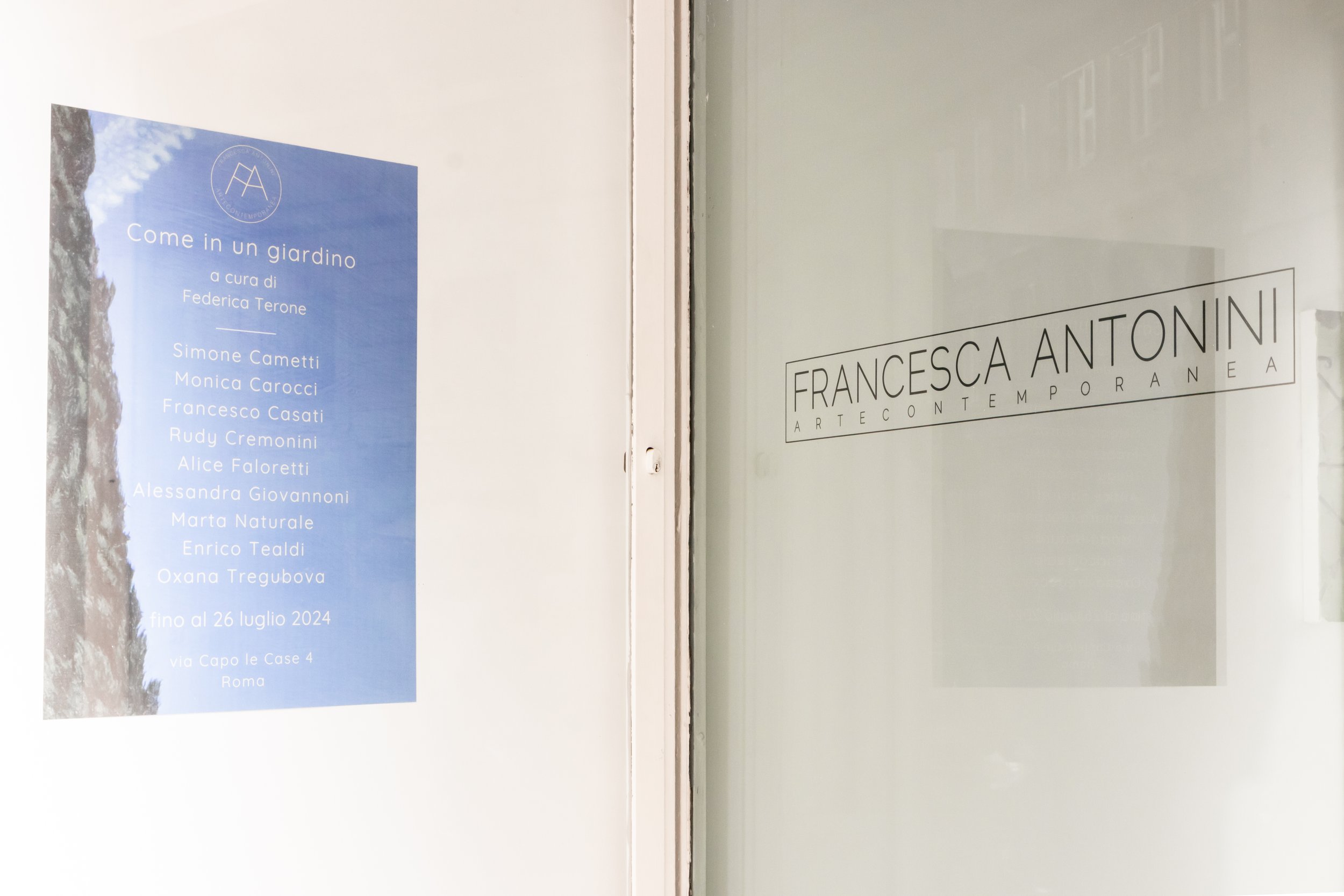COME IN UN GIARDINO
SIMONE CAMETTI, MONICA CAROCCI, FRANCESCO CASATI, RUDY CREMONINI, ALICE FALORETTI, ALESSANDRA GIOVANNONI, MARTA NATURALE, ENRICO TEALDI, OXANA TREGUBOVA
OPENING THURSDAY maY 23RD 2024
UNTIL FRIDAY JUNE 26TH 2024
COME IN UN GIARDINO
FEDERICA TERONE
Unlike its peers, which sometimes seem to react in no way to external stimuli - almost to the point of seeming inert or disinterested - there is a plant that possesses the extraordinary ability to respond to danger. Bending over when touched or when night comes, in a manner reminiscent of the deliberate activity of animals, Mimosa Pudica never ceases to generate awe and wonder.
Since ancient times, humans have felt the need to categorize all forms of biological life, pigeonholing them into specific groups according to their individual peculiar characteristics and, above all, creating a clear separation between animal and plant kingdoms.
Mimosa pudica was able to create a bridging link between the two, made even more solid by an experiment conducted in 2011 by Monica Gagliano and Stefano Mancuso (1): by dropping some seedlings over and over again from a predetermined height of 15 centimeters and provoking an instinctive reflex (i.e., the rapid closing of the leaves), the scholars proved that what initially appeared to be a threat, after several sessions became a harmless experience, in which it was no longer necessary to close to protect oneself from harm. Being able to ignore the fall, this small plants showed that they knew it and could remember it, thus no longer perceiving it as a real danger.
Whereas in the past it was believed that plants could only respond in the programmed ways inscribed in their DNA, it was discovered that their behavior, instead, was learned.
This example is just one of many that overturns the hierarchy we have constructed over the centuries, in which - relegated to the lower ranks - we have deemed plants to be beings lacking subjectivity, intelligence and will. It is necessary to abandon the rampant reductionist approach and finally learn all that the peculiar complexity of the plant world can teach us.
Come in un giardino is based precisely on this premise: welcoming innovative models in which even what is not visible plays a primary role.
If, in fact, "our idea of a plant has always been of something that sprouts from the ground, as if by a miracle, and rises upward" (2) it is important not to overlook what scientists call the hidden part. It is, in fact, in the subsoil that most of the exchanges take place, here water and nutrients are absorbed and the roots become a tool for communication, exchange and reproduction: an extremely complex apparatus.
More generally, unlike animals, which are equipped with specialized (single or dual) organs, plants are organisms that know how to distribute their functions over the entire body.
Come in un giardino is an invitation to establish a new connection with the green: from the ages of time, plants have been our home; only recently have we become detached from them, and this estrangement has not been without consequences. The works in the exhibition-nine, one for each artist invited to explore and deepen the human - nature relationship - are an opportunity to deepen individual research while generating unexpected dialogues.
1 Monica Gagliano, Così parlò la pianta. Un viaggio straordinario tra scoperte scientifiche e incontri personali con le piante, Edizioni Nottetempo, Milano 2023 2 Stefano Mancuso, Botanica. Viaggio nell’universo vegetale, Aboca Edizioni, Sansepolcro (AR) 2021, p.55
-
Rudy Cremonini (Bologna, 1981) often refers to his artworks using the term ‘protection'. As a matter, Come un pezzo di Battisti provides the viewer with a glimpse of an urban nature, seen behind the grates of a gate, typical of the parks found in our large cities. The viewer's gaze looks from the outside to an inside that is all to be imagined, only partially revealing a certain grassy greenness that may remind of rainy days. The green foliage blends with the grates in a set of fuzzy shapes that blend into each other.
Enrico Tealdi’s (Cuneo, 1976) works show dreamy atmospheres. The artist portrays pleasant places transposed into timeless contexts. Every realistic element is reinterpreted in a strong evocative key to create evanescent images: cohesive nuclei of rarefied forms and blurred contours, made with dusty hues. With artistry and delicacy, an aesthetically beautiful - even if unmade - peaceful and benevolent nature is described. If the human figure often completes his landscapes on tiptoe (sealing the newfound union between man and nature) in the painting is absent, leaving the landscape as the sole protagonist.
Alessandra Giovannoni's (Roma, 1954) work gives us views of Rome, in which the relationship between nature and urban layout is inescapable. Her paintings are the result of a direct experience of the landscape - punctuated by frequent long walks - in a process of continuous observation of reality. As she traverses the city, Giovannoni records annotations and visual notes that she then translates into painting. Il Pincio describes a small sunny portion of Villa Borghese, next to the Moses fountain, whose elements are constructed through a skillful use of light and shadow, where man is a silent presence.
Alice Faloretti (Brescia, 1992) has never painted anything but nature. Her works show primordial and unexplored spaces: forests and caves, often hostile and insidious, capable of instilling fear. Realistic cues and instances of fantastic order coexist: the painted landscape does not exist in itself but is the result of the combination of different iconographic episodes, drawn from the most diverse places. Enigmatic and alienating plant visual elements, often rendered in a chromatically anti-naturalistic manner, are the tools Faloretti uses to express a type of conflicting relationship between natural elements and human presence.
Oxana Tregubova's (Russia, 1990) artistic research is inspired by the story of the Garden of Eden. Eden was man's first home, the place of his first encounter with nature. A virgin nature, an oasis of shapes and colors, where vegetation is free to grow without being exploited by man. The eponymous series evokes the symbolism of the biblical garden, when man still knew how to appreciate the holiness of creation. Hortus conclusus celebrates the garden as a place of physical and spiritual consolation, within which man performs with care, love and attention all those small gestures necessary to make a plant grow.
Monica Carocci's (Roma, 1966) shot of the Copenhagen countryside captured a scene of everyday conviviality: three women chat while sunbathing, surrounded by a welcoming and peaceful nature. In the image, the appearance of the vegetation is transformed by repeated interventions made by the artist in the darkroom, directly on the negative. The privileged use of analog - a distinctive element of her photography - and the continuous changes made to the image with acid baths, abrasions and tearing, give the Danish vegetation an anti-naturalistic appearance.
Marta Naturale (Mirano, 1990) used to paint 'urban natures': small corners of everyday life managed in the form of the human hand. Exploring the spaces closest to her, the artist portrays the boundary between nature and artifice. According to a meticulous and manic exercise foliage and arboreal ramifications are punctually rendered. The relationship between nature and man-made space is an element of inquiry dear to her. It passes through the symbolic connotation that man projects onto nature. To the cypress tree, man has wanted to associate the passage between life and death. In doing so, he turned it into an emblem of spirituality and transcendence, which is why he plants it next to cemeteries, to enable his loved ones to 'live forever'.
Much of Simone Cametti's (Roma, 1982) poetics comes through actions performed in direct contact with nature, moving and performing within it. To make Redshift, the artist, finding himself overnight in the mountains, fired boat rockets into the air, which colored the foliage of the surrounding trees red. This work carries forward the studies conducted for some time now on light: the rockets - and the action the artist performs by firing them - become the propulsion system for it, illuminating a portion of vegetation otherwise not visible. A perfect interplay of human-nature cooperation.
Francesco Casati (Verona, 1990) uses painting to bring to life an imagery suspended between reality and fiction. The recurring subjects of his paintings, blurred in features and cast in rarefied atmospheres, are arranged in poses that oscillate between balance and disequilibrium. Floralia portrays a young woman, in a pose as expressive as it is extravagant, floating in a space entirely formed by decorative patterns that refer to the plant world. The girl shows a multicolored hair made up of different varieties of flowers, in a multitude of colors and shapes: a symbol of prolific nature, expanding undisturbed in the space.




























